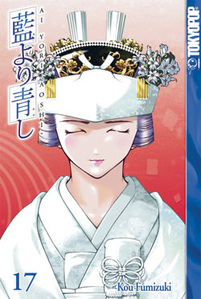Review
by Theron Martin,Ai Yori Aoshi
GN 17
| Synopsis: |  |
||
Aoi has finally and forcefully (by her standards) declared to her parents that she will give up her family ties to live with Kaoru, who has arrived on the scene. But will Kaoru's jealous younger half-brother let them go at that, or does their grandfather's will leave him no say in the matter? And what is to become of Kaoru and Aoi now that they are finally together and can openly declare their love and relationship? How will the other girls react when they find out, and what will become of Miyabi? All will be put to rest in this concluding volume. |
|||
| Review: | |||
Since its early stages the main source of tension in Ai Yori Aoshi has always been the inability of central couple Kaoru and Aoi to openly declare and live their love because of the complicated constraints put on them by family ties. Though that problem has come to a head once or twice before, here, finally, the issue is resolved once and for all, and the resolution that forms the main plot point actually happens fairly quickly by the glacial pacing standards of the series. That leaves the remaining six chapters to serve as clean-up duty, which seems like an appropriate proportion for a series that encompasses 17 volumes. Because of that, the series ends with all of its loose ends neatly tied up. Whether or not that actually will leave long-time fans of the series completely fulfilled is another story, and satisfaction levels will vary. Any ending other than the one that happens would not have fit, however, and Ai Yori Aoshi has rarely been a series to surprise its readers. Nothing that happens here should catch anyone off guard; indeed, in many senses the entire volume serves as one big hunk of fan service, as it gives fans everything that they could ask for in the final volume – and yes, that means what you think it does. Tokyopop assigned an Older Teens rating to all 16 previous volumes because of Kou Fumizuki's penchant for somehow working detailed female nudity into every volume, but this one gets a Mature rating, a “Parental Advisory” tag, and the shrink-wrap treatment. They are deserved, too, because the detailed rendition of the long-anticipated love scene, which takes a full two chapters to play out, goes far beyond anything normally seen outside of hentai titles. The scene is not so uncouth as to be completely explicit, but given Aoi's long-standing insistence that she wants to belong to Kaoru in body as well as mind and soul, not including a scene like this would have been a disservice. And why disappoint fans of the series? After all, for all its well-mannered behavior and emphasis on propriety, this is not Oh My Goddess!. The other significant development in these pages is, at long last, an explanation for the name of the series, which has always been romanized but never officially translated. Though the tag line “True Blue Love” is often associated with the series, a more literal translation of the original kanji has always been “Bluer Than Indigo,” which makes little sense out of context. It does, in fact, refer to the way an indigo-dyed kimono shifts to a vivid blue color through long-term wear, which Aoi uses as a parallel for the development of the love that she shares with Kaoru. Given that Aoi has almost always dressed in traditional Japanese clothing, it demonstrates the remarkable and exquisite care with which the name was chosen. Over the last two volumes of the manga a noticeable change has happened with Fumizuki's character designs. Compared to earlier volumes the designs in general have become much more thick-necked, Tina has assumed a more masculine build, and Aoi's features have taken on a more boyish cast (though her figure certainly has not). The sum result is a set of character designs much less appealing than earlier in the series, which contributes greatly to the visual mediocrity of some scenes. Background detail has also fallen below the quality standard set earlier in the series. The best artistry actually comes in the meticulously detailed depiction of Aoi's bra, although Fumizuki also chooses well in what he shows in the love scene and what he uses as a closing shot. The wonderfully detailed color cover art of Aoi in elaborate Japanese wedding dress, as well as the cute, colored chibi renditions of Aoi and Kaoru in Japanese wedding regalia (inside the front cover) and Western wedding regalia (inside the back cover), try to make up for the quality drop-off elsewhere but do not quite succeed. As per the norm for this series, Tokyopop's production includes brief character profiles and a series summary at the beginning and accompanies sound effects with small, innocuous translation. The final Ai-Ao Theater installment precedes the next-to-last chapter. Even popular harem romantic comedies must eventually come to a conclusion, and at least this one actually has a proper ending. It also, thankfully, ends before its content completely loses its freshness. |
| Grade: | |||
|
Overall : B
Story : B
Art : B-
+ Offers everything fans could ask for, content-wise, in the close-out volume. |
|||
| discuss this in the forum (6 posts) | | |||
| Production Info: | ||
|
Full encyclopedia details about Release information about |
||